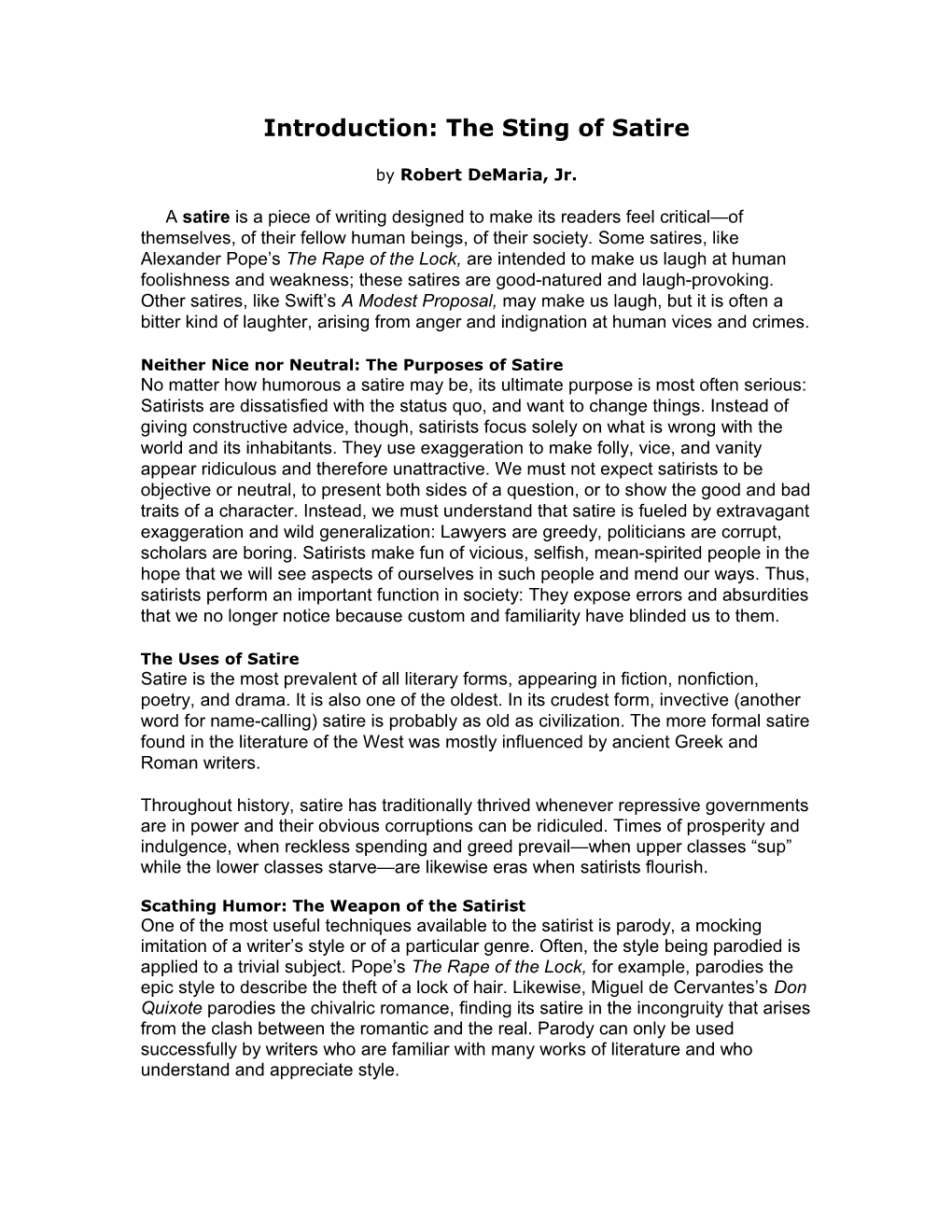Introduction: The Sting of Satire
by Robert DeMaria, Jr.
A satire is a piece of writing designed to make its readers feel critical—of themselves, of their fellow human beings, of their society. Some satires, like Alexander Pope’s The Rape of the Lock, are intended to make us laugh at human foolishness and weakness; these satires are good-natured and laugh-provoking. Other satires, like Swift’s A Modest Proposal, may make us laugh, but it is often a bitter kind of laughter, arising from anger and indignation at human vices and crimes.
Neither Nice nor Neutral: The Purposes of Satire
No matter how humorous a satire may be, its ultimate purpose is most often serious: Satirists are dissatisfied with the status quo, and want to change things. Instead of giving constructive advice, though, satirists focus solely on what is wrong with the world and its inhabitants. They use exaggeration to make folly, vice, and vanity appear ridiculous and therefore unattractive. We must not expect satirists to be objective or neutral, to present both sides of a question, or to show the good and bad traits of a character. Instead, we must understand that satire is fueled by extravagant exaggeration and wild generalization: Lawyers are greedy, politicians are corrupt, scholars are boring. Satirists make fun of vicious, selfish, mean-spirited people in the hope that we will see aspects of ourselves in such people and mend our ways. Thus, satirists perform an important function in society: They expose errors and absurdities that we no longer notice because custom and familiarity have blinded us to them.
The Uses of Satire
Satire is the most prevalent of all literary forms, appearing in fiction, nonfiction, poetry, and drama. It is also one of the oldest. In its crudest form, invective (another word for name-calling) satire is probably as old as civilization. The more formal satire found in the literature of the West was mostly influenced by ancient Greek and Roman writers.
Throughout history, satire has traditionally thrived whenever repressive governments are in power and their obvious corruptions can be ridiculed. Times of prosperity and indulgence, when reckless spending and greed prevail—when upper classes “sup” while the lower classes starve—are likewise eras when satirists flourish.
Scathing Humor: The Weapon of the Satirist
One of the most useful techniques available to the satirist is parody, a mocking imitation of a writer’s style or of a particular genre. Often, the style being parodied is applied to a trivial subject. Pope’s The Rape of the Lock, for example, parodies the epic style to describe the theft of a lock of hair. Likewise, Miguel de Cervantes’s Don Quixote parodies the chivalric romance, finding its satire in the incongruity that arises from the clash between the romantic and the real. Parody can only be used successfully by writers who are familiar with many works of literature and who understand and appreciate style.
Key Information about Satire:
Its purpose:
Common elements or techniques used by writers of satire:
hyperbole:
parody:
verbal irony:
diction:
humorous tone:
Which of these elements are present in the satire you have watched today?
What elements of society is this show satirizing?
hyperbole : extreme exaggeration
parody: a work created to mock, comment on, or poke fun at an original work, its subject, its author, or some other target, Parody uses a humorous tone typically, and is sarcastic or ironic imitation of the original.
verbal irony -- figure of speech in which what is said is the opposite of what is meant – sarcasm, extreme overstatement, extreme understatement
diction -- the choice of words, their arrangement, and the force, accuracy, and distinction with which they are used. Jargon, slang, phrasing, connotation are all important to pay attention to when analyzing diction in satire.
Humor is usually present in satire – It can be the primary tone or an underlying one often depending on how serious the author is about affecting change or persuading the audience toward his opinion.
